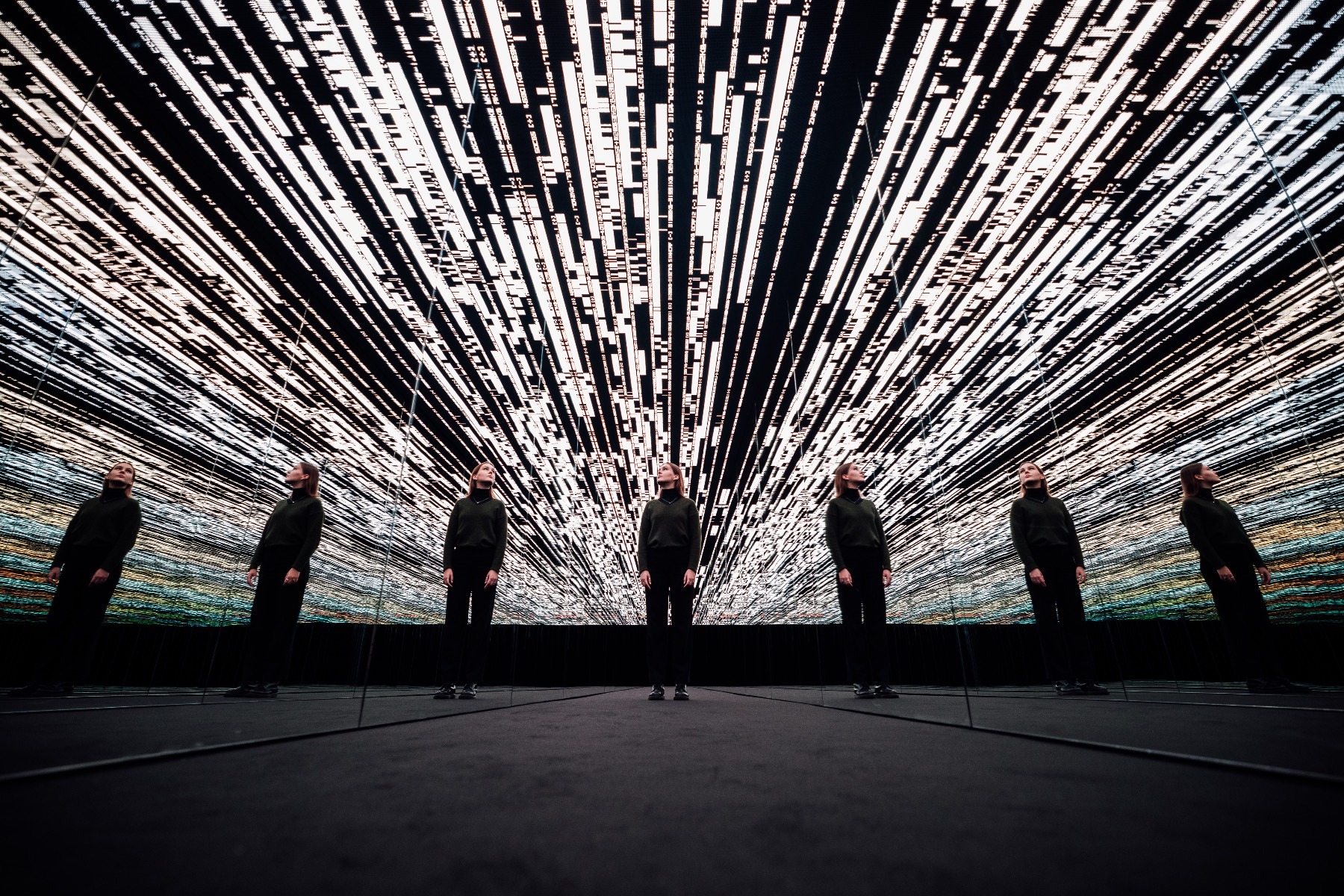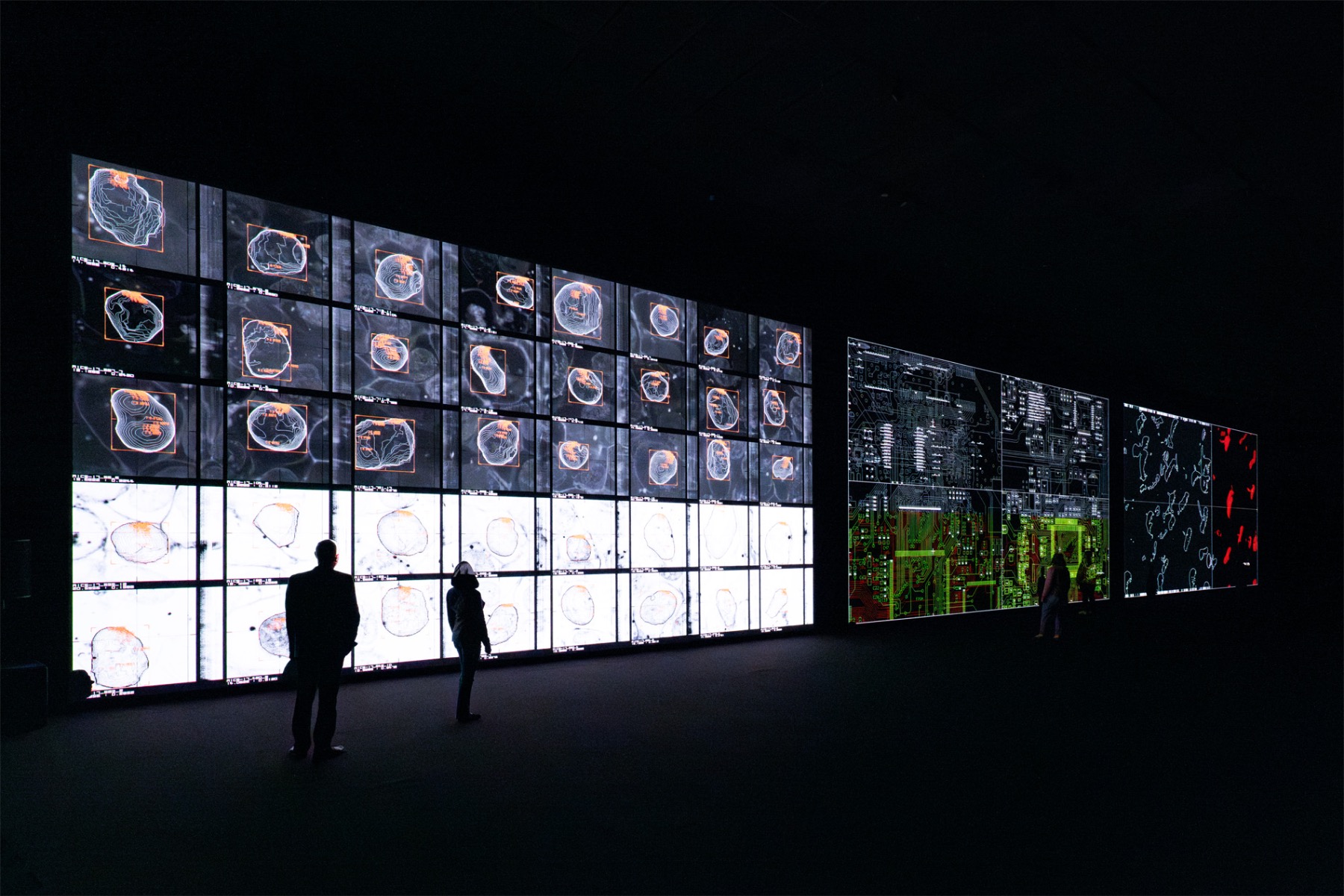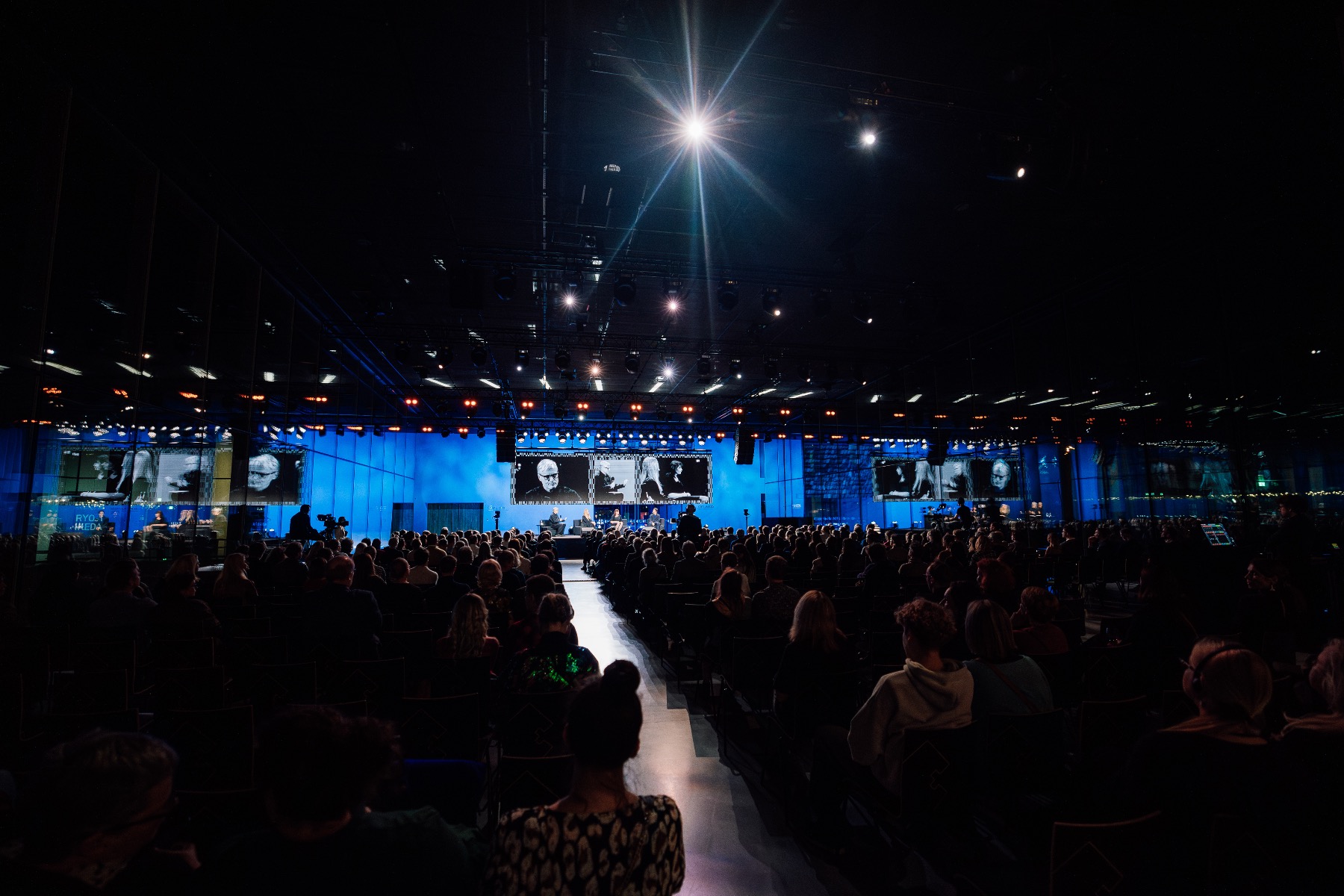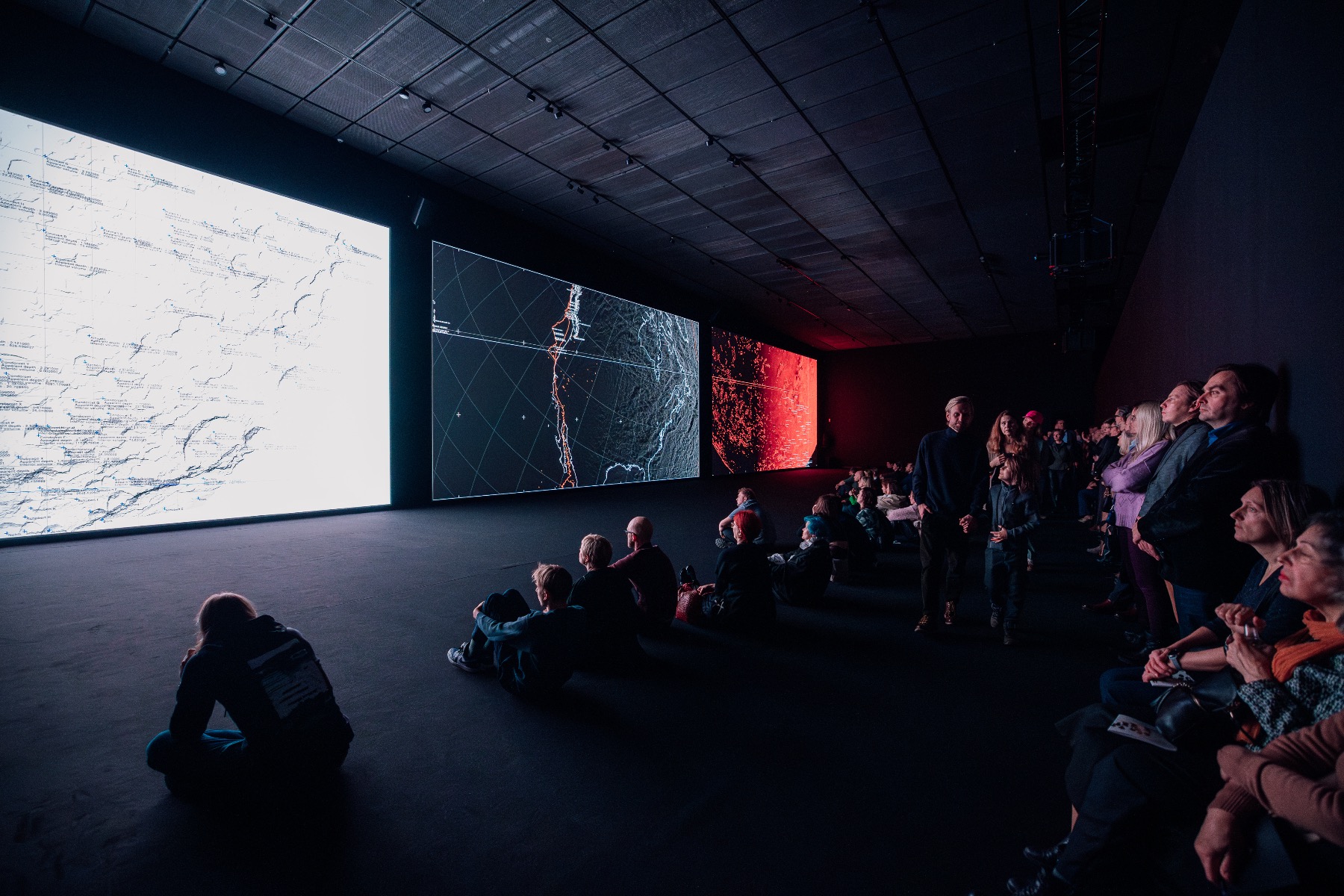
Ryoji Ikeda’s Data-Universe in Tartu
Photo: European Capital of Culture Tartu 2024
As part of the European Capital of Culture 2024 programme, the Estonian National Museum in Tartu has opened a major exhibition (on view until 02/03/2025) by Japanese artist Ryoji Ikeda (Japan, 1966) that focuses on data as the foundation of our collective memory and future. The official concept of the European Capital of Culture Tartu 2024 is ‘Arts of Survival’, and it has been developed along four thematic lines. Ikeda’s solo exhibition is part of the ‘Tartu with Universe’ (sic) programme, which focuses on innovation as well as global change driven by rapid scientific and technological developments that affect both individuals and communities.
The core of the exhibition consists of two special works – vox aeterna (2024) and the critical paths (2024) – created in close collaboration with two significant institutions in Estonia and Tartu – the Estonian Philharmonic Chamber Choir and the Institute of Genomics at the University of Tartu. Created specially for Tartu 2024, the first work gives the audience the opportunity to experience primordial manifestations of the human voice, while the latter lets the audience experience the visual dimension of data flow.
The exhibition also includes a major work by Ikeda – the trilogy data-verse 1/2/3 (2019–2020). Having worked on it for almost 20 years, it contains datasets from 45 scientific disciplines. This grand data visualisation project allows viewers to experience the scale of nature at all levels, from the microscopic to the cosmic.
Ryoji Ikeda. the critical paths (2024)
Ikeda’s participation in Tartu 2024 is based on several complementary aspects that justify his suitability for this event. Firstly, Ikeda is well known to Estonian audiences since his previous exhibition Supersymmetry, which took place at the KUMU Museum at the turn of 2015/2016 and was widely acclaimed, thereby forming the basis of the artist’s close connection to the local cultural environment. This successful collaboration also laid the foundations for further research into the Japanese artist’s work in the context of Tartu 2024.
Secondly, the venue of the exhibition, the Estonian National Museum, is not only dedicated to the preservation of local history, but also develops a vision of the future permeated by the integration of science and technology. Ikeda’s artworks, based on data visualisation and scientific research, ideally complement the scientific nature of the museum. His ability to translate scientific data into sensuous and visually immersive installations enriches the visitor experience and creates a unique symbiosis between art and science. The museum's architect, Tsuyoshi Tane, says: ‘The museum has always aspired to be more than a place to preserve the past – it is designed for the 21st century and with an eye to the future’. The architecture of the museum building, which rises from the runway of a former military airfield, is also symbolic of the transformation of the past into a future in which technology and contemporary culture play a central role. Such a museum of the future offers an environment where history is preserved alongside contemporary cultural and artistic events, concerts, and meeting places, and allows for a lively dialogue between the past and the future.
Ryoji Ikeda. data-verse 1/2/3 (2019–2020)
Thirdly, the city of Tartu and Ikeda share a close link with science, as Tartu is the centre of Estonian scientific research and Ikeda has collaborated with organisations such as CERN and NASA for more than 20 years. This shared interest in the development of science, technology and innovation creates a strong resonance between his work and the goals of Tartu 2024.
Finally, the Japanese and Estonian cultures share a spirit of creativity and innovation, as well as a respect for nature. Ikeda’s involvement in the programme highlights this similarity of values and makes his presence symbolic.
And above all, a kind of magic and serendipity permeate the making of the programme. In particular, Japanese-born architect Tsuyoshi Tane (from the architecture office firm Dorell.Ghotmeh.Tane) worked on the design of the Estonian National Museum building, which was built in the previous decade; it was was so outstanding that it put Tartu on the map the European museum scene, which, in turn, boosted Tane’s own international career. This time, Tane is involved in the design of the Ikeda exhibition space. The two creatives are close friends and live only a few hundred metres apart in Paris, yet each has been connected to Tartu in their own time and in their own way: Ikeda had an exhibition at the KUMU Museum in 2016, whereas Tane led the development of the National Museum project.
Ryoji Ikeda. data-verse 1/2/3 (2019–2020)
In addition to these coincidences, another important element was unexpectedly added during the exhibition: Ikeda’s concert programme, which had its world premiere the day after the exhibition’s opening. This concert, in which Ikeda collaborates with the Estonian Philharmonic Chamber Choir (conducted by Tõnu Kaljuste), was inspired by his long-standing fascination with Estonian music – at first with the work of ArvoPärt, and later, the Estonian Philharmonic Chamber Choir – and this was long before he had any direct connection to Estonia. Ikeda's composition, created specially for this choir, is not only the fulfilment of a long-held dream, but also forms another artistic link with the region.
Panel discussion with Ryoji Ikeda, architect Tsuyoshi Tane, curator Kati Torp, and Kristiina Tambets, researcher at the Institute of Genomics, University of Tartu
In the opening panel discussion with Ikeda (an exclusive occasion since Ikeda rarely agrees to speak in front of an audience (!)), the artist was asked if he is trying to change our perception of reality by bringing the viewer into a new dimension of feeling and consciousness through art, to which he replied: ‘That is not my goal. My responsibility is simply to create, and my passion is composition – whether it's arranging sounds in music, organising pixels in visual works, or transforming data into abstract forms. I love to construct, put together, create, and see what organically comes out of it.’ Ikeda also emphasises that his aim is not to make the audience intellectualise his work, but to let them feel it and experience it on a personal, emotional level. ‘I don’t prescribe how viewers should interpret my work, nor do I expect a specific reaction. For me, art is a 50/50 collaboration: I create one part, and the viewer completes it with their presence.’
It is this intuitive approach to art that permeates the exhibition’s works in which scientific data become the basis for unique experiences. The first work that brings the viewer into this world of Ikeda is vox aeterna (Eternal Voice), a multi-channel sound installation created especially for Tartu 2024. In this work, vocal recordings by the Estonian Philharmonic Chamber Choir are transformed into a multi-voiced piece that reflects the primordial nature of the human voice – from a baby’s first cries to a child’s laughter. Encompassing the entire spectrum of human existence, this soundscape captures early emotions and creates a mysterious, atmospheric space.
the critical paths, Ikeda's latest audiovisual work, has visitors navigate through a 25-metre-long mirrored corridor with LED screens on the ceiling. Here, genetic data from the University of Tartu's Institute of Genomics – DNA information from a total of 100 000 Estonians – is fluidly displayed, giving viewers the opportunity to immerse themselves in human history and reflect on personal ‘critical paths’ – our life challenges and choices and how they shape our ability to adapt and evolve. This data stream also serves as a metaphor for human evolution – a process that Ikeda sees as continuous and future-oriented. As one of the panellists, Kristiina Tambets, a genomics scientist at the University of Tartu, points out: ‘Collaborating with an artist who draws inspiration from the Institute's biobank data seemed like a natural extension of our work. The result is a project that shows how closely our heritage and our future are intertwined.’
Ryoji Ikeda. data-verse 1/2/3 (2019–2020)
In addition to these works, the exhibition is accompanied by a grand data visualisation artwork – the trilogy data-verse 1/2/3 (2019–2020), which is not a part of the works commissioned for Tartu 2024 but premiered at the 2019 Venice Biennale. This data-driven audiovisual exploration brings together data from CERN, NASA and the Human Genome Project, offering viewers a glimpse into three worlds: the microscopic (elementary particles, molecules, cells), the human world (brain, body, climate, internet) and the macroscopic (Earth, the Solar System, galaxies). This trilogy reveals the scales of nature at all levels, and Ikeda's virtuosity can reveal dimensions of data that would otherwise remain hidden. The artist himself underlines the importance of this common humanity by saying: ‘My countless encounters with scientists and mathematicians have shown me that, despite our different approaches, we all have something in common. Whether we are Estonians or Japanese, scientists or artists – we are all human’. He applies the same principle to his own identity, affirming that although he is genetically Japanese, artistically he belongs to the world. People often try to stereotype his work, for example, by associating it with Zen, but he himself aims to work outside of such categories and calls for focusing not on the different but on what unites us.
Kati Torp, Creative Director of Tartu European Capital of Culture 2024 and curator of the Ryoji Ikeda exhibition, highlights Ikeda's ability to combine the intellectual and the sensual, creating tangible experiences from scientific data: ‘His ability to turn abstract scientific data into a visual experience is truly impressive. His art makes complex and often inaccessible scientific concepts accessible and understandable’.
In this way, Ikeda’s presence at Tartu 2024 creates a multidimensional dialogue between science and art, and demonstrates the importance of interdisciplinary interactions that contribute to the emergence of significant and meaningful art events.
Ryoji Ikeda. data-verse 1/2/3 (2019–2020)
Being one of Japan's best-known electronic music composers, Ryoji Ikeda is a strong presence in both visual and sonic mediums. Basic sound features, visual elements, physical phenomena and mathematical concepts are the raw material from which he creates immersive performances and installations. He has held solo exhibitions at prestigious art centres such as the Park Avenue Armory in New York, the Hamburger Bahnhof in Berlin, the Centre Pompidou in Paris, the KUMU Art Museum in Tallinn, and Amos Rex in Helsinki.
Two of Ikeda’s most impressive projects, which the artist himself described as particularly ambitious during the panel discussion, were Spectra and A [For 100 Cars]. Spectra was a light installation that was projected 15 kilometres into the sky as a white pillar of light, visible from even 100 kilometres away. In Los Angeles, in the parking lot of the Walt Disney Concert Hall, Ikeda staged an unusual car orchestra concert, A [For 100 Cars], featuring 100 cars equipped with powerful loudspeakers.
In the field of music, Ikeda has made a name for himself with innovative electronic albums, including +/- (1996), 0°C ( 1998), matrix (2000) and supercodex (2013), which are characterised by stark minimalism. In collaboration with various collectives, Ikeda has created important acoustic works such as music for percussion (2016), A [for 100 cars] (2017) and 100 cymbals (2019). His latest album, ultratronics (2022), continues these experiments.
The Estonian Philharmonic Chamber Choir and Ryoji Ikeda
Next year, in 2025, one of Ryoji Ikeda’s most anticipated works will see the light of day: a permanent installation commissioned by the Grand Paris Express for the new Pont de Sèvres metro station in Paris (architect Henri Dutilleux). It is also possible that the concert programme that Ikeda initiated with the Estonian Philharmonic Chamber Choir (nine pieces with English and Latin texts), which had its world premiere the day after the opening of the exhibition at the Estonian National Museum in Tartu, will also travel to Paris.
Title image: Ryoji Ikeda. data-verse 1/2/3 (2019–2020)